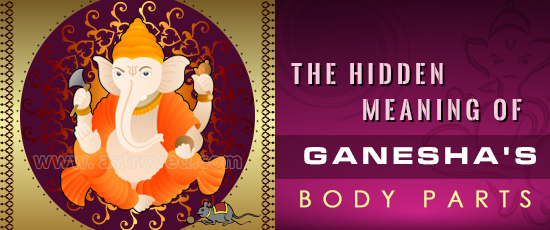Hidden Meaning of Ganesha’s Body-parts
The Hindu god Ganesha is stocky, pot-bellied and elephant-headed. And, he rides on a mouse! To a foreigner He certainly presents a curious as well as freakish image. Only when the Indian culture uncovers itself to this foreigner, he realizes how widely worshipped and revered is Ganesha - He is part and parcel of Hindu psyche. People love and adore him so much that he is invoked in most of the auspicious ceremonies.
His imagery helps us think beyond anything that is common or regular. He helps us realize the potentials of our nature and how to liberate mind from its acquired limitations. Meditating on his imagery we understand the philosophy of Hinduism. https://www.youtube.com/watch?v=c1Po4Fsi69A Ganesha’s Elephant-head - It is the elephant face with a trunk that makes Ganesha unique. What make an elephant majestic, is not only its enormous size but also its sensitivity, compassion in character, intelligence to think without limitations and strength of character to remove obstacles from its way. Ganesh’s face epitomizes all that. This abstract and creative image of elephant head on human body is symbolic of abilities of human brain unknown to us. Puranas relate that Ganesha shows the doorway for realization of universal truth that is not only beautiful but also abstract. Trunk of Ganesha – Ganesha’s trunk represent the Om symbol. With trunk turned to the left, he is called Vamamukhi. Energy flow of the Moon (Moon energy channel) occupies the left side of our body and is responsible for qualities of mind such as calmness, tolerance, patience and our creative aspects. He is usually worshipped in households. When this trunk depicts eating sweet balls or laddu it is an indication for material prosperity and comforts.
Ganesha with his trunk turned to the right direction is Dakshinabhimukhi murti. He is also called Siddhi Vinayaka. The trunk is indicative of the Sun channel within our body. This Ganesha helps in attaining ultimate happiness and moksha. According to Mudgal Purana, Ganesha’s left-side trunk indicates Rajasic (being active) qualities in us, right-side trunk indicates Tamasic (being slow or inactive) qualities, and trunk in the middle indicates Satwik or enlightenment. Hands of Ganesha – Ganesha’s hands depict philosophy of Hinduism. In one hand he holds Lotus, symbolizing beauty of reality and enlightenment. In second hand he holds an axe or a hatchet, sometime a chakra or noose that signify detachment from all past karma, and narrow beliefs. In the third hand he holds laddu or the sweet ball signifying pleasures of knowledge and wisdom. His fourth hand is in abhaya mudra or granting boons. Some idols of Ganesha are also found holding broken task as if holding a pen. This reminds us of his contribution in writing the epic Mahabharata using his task. Single Tusk of Ganesha – Ganesha has one tusk, and he is also called Ek-Danta. Mudgal Purana relates that single tusk denotes singularity of Nature or the Absolute Truth of Universe. He is God of prosperity, Remover of obstacles, and God of wisdom. His image is artistic, creative and unique. Meditating on different parts of his body brings unique insight about life. Read our related articles How to Celebrate Ganesh Chaturthi























